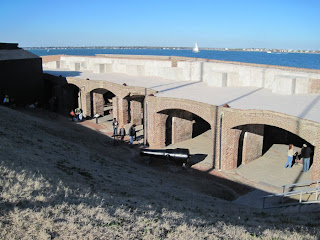
Join me on the deck of the ferry as we make our way across Charleston Harbor to Fort Sumter. It was cool that day, but sunny. There are 2 locations to catch the ferry to Fort Sumter, one is Liberty Square in downtown Charleston. Boat is in fact, the only method of getting to the fort.

As we approach Fort Sumter you might question where the fort is. I did. It doesn't really look like a fort. Truthfully there's not much left that resembles what it used to look like during The Civil War.

Take a look at this map and you'll get a sense of the importance of this harbor. There's Fort Moultrie on Sullivans Island, Fort Wagner on Morris Island, Fort Sumter, and Fort Johnson on James Island among other military outposts and batteries. Look at the proximity to Charles there on the tip. Fort Sumter was built after The War of 1812 as a means of protection against would be invaders, and named for Thomas Sumter a Revolutionary War Veteran from South Carolina. It was built with lots of slave labor, and was in fact unfinished when Major Robert Anderson made his move there with 85 men.

Fighting lasted some 34 hours while this Federal Fort was still in the hands of The United States and occupied by The Union forces.

He you see a drawing showing the original 3 story structure of the fort before the it was severely destroyed.

A Memorial to Major Robert Anderson and his garrison of brave men who tried to preserve The Union, The United States that fateful day in 1861. Major Anderson fought against a student of his from Westpoint, Brig. Gen. Pierre G.T. Beauregard

Major Anderson and his wife and son pictures.

A general view of the harbor and the cannons.

Cannon up close.

After the close of The Civil War the fort fell into disrepair but what once again deemed important prior to the onset of The Spanish American War in 1898. This Battery Huger now overtakes much of inside area of Fort Sumter. Though the Huger was not needed for that war, the military did maintain the area. In World War I a larger and more power weapon was installed. It became a tourist attraction after that period, but was once again reactivated for World War II. In 1943 The War Department transferred ownership to The National Park System and it became a National Monument.

Sometimes I view historic places of interest difficult places to take family, at least family with small children. Guided tours are often not child friendly. Kids want to run and play and not listen intently to a docent or ranger giving a lecture. However, if a Junior Ranger Program exists, then please do take the children. They'll love it, learn a lot and most likely be able to tell you a thing or two. I know our daughter always enjoyed these programs at National Parks and Monuments and felt so proud when she'd earn her badge.

This is The Battle Flag that flew proudly for The Union, The United States of America. It is as you can very thin, a bit torn, and behind glass. Not only is it behind glass it's in a special wooden case, an airtight on in order to preserve it. The glass is specially tinted glass also to protect the flag. Notice the arrangement of the stars. There was no "official" placement of stars on the flag in those days. In fact there wasn't for quite some time. The placement of stars was merely up to the seamstress and so 2 flags side by side would look different.
















